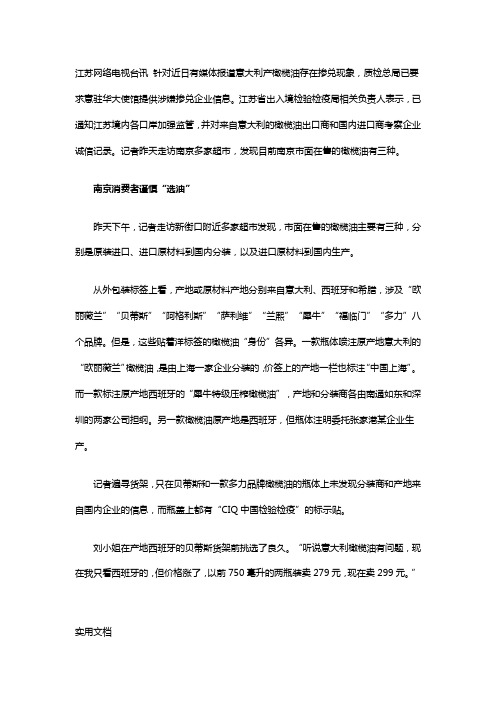橄榄油的骗局及其鉴别手法
橄榄油掺伪鉴别中拉曼光谱技术的应用研究

不经过任何热和化学处理的初榨橄榄油保留了橄榄特有的味道和营养,使广大消费者争相抢购,其品质评价方法一直是国内外研究的重点。
拉曼光谱技术可以对橄榄油进行无损鉴定,因其高效准确等优点,已被目前大多数橄榄油相关鉴定人员采用。
一、拉曼光谱在橄榄油掺伪上的应用目前,橄榄油掺伪主要分为两种形式,一种是将劣质橄榄油和橄榄果渣油加入优质橄榄油种;另一种是把其他廉价实用油加入橄榄油中,如玉米油、榛子油、花生油、地沟油等。
而拉曼光谱技术具有速度快、效率高、灵敏度高等特点,可以分析橄榄油成分含量,鉴定橄榄油是否掺伪。
首先,不同食用油在光谱上的差异很小,如果只看差异的话难以有效鉴定橄榄油掺伪情况,因此在鉴定过程中通常需要结合聚类分析、偏最小二乘法、判别分析等化学计量学方法。
通过与计量学方法的结合,拉曼光谱技术可以精确到确定橄榄油中是否混合5%类型的油,能区分初榨橄榄油和其他食用油,定向分析橄榄油掺伪检测,且成本低、时间短、过程相较于其他方式更为简单。
其次,目前国内外已经开始研究拉曼光谱技术对橄榄油掺伪的检测。
比如,拉曼光谱通过类胡萝卜素含量鉴别橄榄油真伪,类胡罗卜素这种高度共轭化合物的C=C的伸缩震动可以引起拉曼光谱在1525cm-1处有吸收峰,橄榄油在精炼过程中里面的类胡萝卜素会消失,所以类胡萝卜素仅存在于初榨的橄榄油里面,因此拉曼光谱技术可以通过对类胡萝卜素的鉴定来判断橄榄油真伪。
最后,研究发现75%的优质初榨橄榄油在1265cm-1的位置拉曼光谱强度要小于540,而再优质初榨橄榄油中加入果渣油会让拉曼峰在1265到1650cm-1之间的强度增加,所以,高于该数值的橄榄油就可能存在造假的问题。
与其他鉴定橄榄油真伪的方法相比,谱图更为方便直观,精确高效,而且还不需要大量数据的计算,能更大程度的节省不必要的人力。
二、拉曼光谱对橄榄油的品质鉴定1.有效评价橄榄油的不饱和程度不饱和度是判断橄榄油品质的一个重要指标,拉曼光谱可以准确测定橄榄油不饱和度。
食用油四大扯淡,你被忽悠过几个?

食用油四大扯淡,你被忽悠过几个?在这形形色色的营销噱头中,这四个堪称“四大忽悠”,或者“四大扯淡”。
第一、“黄金比例调和油”所谓“黄金比例调和油”,是说WHO推荐“饱和脂肪酸:单不饱和脂肪酸:多不饱和脂肪酸的比例应该为1:1:1”,而天然食用油中没有一种满足这一比例,于是厂家通过把多种食用油混合“调和”,从而得到符合这一“黄金比例”的食用油。
实际上,WHO作为一个机构从来没有推荐过这个比例。
这个说法,实在WHO的一次会议上,有专家提出来而已,并没有得到认可。
但在中文媒体上,这个“WHO推荐”的说法广为流传,甚至一些营养师也引用了。
而目前厂家的文案是:来自于黄金比例调和油的宣传资料这就相当于有人大代表交了个提案建议实行XX制度,就被演绎成“人大决议实行XX制度”。
WHO对三类脂肪酸的推荐是这样的:总的脂肪供能比不超过30%,其中饱和脂肪供能比低于10%,多不饱和脂肪供能比6-11%,其余的是单不饱和脂肪。
(供能比是指该种食物产生的热量占所有食物总热量的比例)。
饱和脂肪只有上限没有下限,即越少越好,而多不饱和脂肪有一个范围。
也就是说,根本不存在什么三者的“黄金比例”。
第二、“橄榄油是婴幼儿的最佳食用油”“婴幼儿橄榄油”的营销文案:某度百科上的词条说“橄榄油是最佳食用油”也就罢了,毕竟它本身也还是一种不错的食用油。
但是把它鼓吹成“最适合婴儿食用的油类”就纯属扯淡。
婴儿期的主要营养应该来自于母乳或者配方奶,其中已经有合理的脂肪组成。
所谓“橄榄油营养成分中人体不能合成的亚麻酸和亚油酸的比值和母乳相似,且极易吸收”,一句话就有两点扯淡:一是婴儿需要的亚麻酸与亚油酸之比,应该在1:5与1:15之间,橄榄油中二者比值是1:14而且总量并不高,而大豆油的比值是1:7.5而且总量比橄榄油高得多;二是哪种油中的亚麻酸与亚油酸都“极易吸收,橄榄油中的没有特殊之处。
至于其他的说辞,也不过是“欲加之好,何患无辞”。
第三、“符合宝宝用油标准的稻米油”某稻米油软文的片段截图稻米油是一种还不错的食用油,不过其脂肪酸组成也不算多优越,此外其中有一些谷维素等微量元素。
买橄榄油的10大忠告

买橄榄油的10大忠告嘿,你想买橄榄油不?那我可得给你点忠告哈。
有一次我去超市买橄榄油,那货架上的橄榄油可真多啊,各种各样的牌子,看得我眼花缭乱。
我也不知道该选哪个好,就随便拿了一瓶。
结果回家一用,哎呀,那味道可怪了,一点都不好吃。
从那以后,我就知道买橄榄油可不能瞎买。
这第一个忠告呢,就是别只看价格。
我当时就是觉得那瓶橄榄油便宜,就买了。
结果发现便宜没好货啊。
橄榄油的价格有高有低,贵的不一定就好,但太便宜的肯定不行。
你得看看它的品质和产地啥的。
第二个忠告,要看清楚标签。
上面有很多信息呢,比如是初榨的还是精炼的,酸度是多少。
有一次我买了一瓶橄榄油,回家才发现是精炼的,营养成分可没有初榨的高呢。
第三个忠告,别被广告忽悠了。
有些广告说得可好听了,啥“最健康的油”“美容养颜”啥的。
可不能全信啊,还是得自己多了解了解。
第四个忠告,要选正规的品牌。
那些没听过的小牌子,说不定质量就没保障呢。
我有个朋友就买了个小牌子的橄榄油,结果吃了拉肚子。
第五个忠告,注意保质期。
橄榄油也有保质期的,过期了可就不能吃了。
买的时候一定要看看日期,别买了快过期的。
第六个忠告,闻闻味道。
好的橄榄油有一股淡淡的果香,要是有怪味,那肯定不行。
我那次买的橄榄油就是有股怪味,后来我才知道那是变质了。
第七个忠告,看看颜色。
好的橄榄油颜色比较绿,要是颜色太深或者太浅,都可能有问题。
第八个忠告,可以试试口感。
买的时候可以在嘴里尝一点,要是有苦涩味或者辣味,那就不好。
第九个忠告,别买太大瓶的。
橄榄油开瓶后容易氧化,要是买太大瓶的,吃不完就浪费了。
第十个忠告,多比较几家。
不同的超市或者网店,价格和品质可能都不一样。
多看看,才能买到性价比高的橄榄油。
所以啊,买橄榄油的时候可得小心点,别像我一样瞎买。
记住这十个忠告,保证你能买到好的橄榄油。
嘿嘿。
在美国这14个品牌的橄榄油居然是假的?!这些品牌不要买啦!

在美国这14个品牌的橄榄油居然是假的?!这些品牌不要买
啦!
加州大学(University of California)最近的一份研究报告显示,美国店面销售的橄榄油中有近70%是假的!研究内容显示,他们只是由便宜的替代品,如油菜籽和向日葵油,经混合作为橄榄油流向市场。
美国人每年在橄榄油上花费7亿多美元,但大多数情况可能是由于橄榄油欺诈而浪费的。
可悲的是,这种被大家所广泛认同的,对我们的心脏和健康最健康的油正被有些不良商人打着“正宗橄榄油”的旗号,用假油来替代向市场出售。
有媒体更加列出清单,忍住以下这14款假橄榄油品牌,购买前千万千万小心啊~~
Carapelli
Mezzetta
Pompeian
Mazola
Primadonna
Colavita
Sasso
Antica Badia
Star
Whole Foods
Felippo Berio
Coricelli
Bertolli
那么,怎样鉴别家里的橄榄油是真是假呢?
有个小方法,可以把橄榄油放在冰箱里半小时,如果它开始凝固,
则意味着油是纯净的,因为含有大量的单不饱和脂肪酸,如果不凝固那就是假的了。
还可以查看橄榄油品牌的标签,看是否有认可的评级,比如说“California Olive Oil Council Certified Extra Virgin”。
如何鉴别橄榄油

江苏网络电视台讯针对近日有媒体报道意大利产橄榄油存在掺兑现象,质检总局已要求意驻华大使馆提供涉嫌掺兑企业信息。
江苏省出入境检验检疫局相关负责人表示,已通知江苏境内各口岸加强监管,并对来自意大利的橄榄油出口商和国内进口商考察企业诚信记录。
记者昨天走访南京多家超市,发现目前南京市面在售的橄榄油有三种。
南京消费者谨慎“选油”昨天下午,记者走访新街口附近多家超市发现,市面在售的橄榄油主要有三种,分别是原装进口、进口原材料到国内分装,以及进口原材料到国内生产。
从外包装标签上看,产地或原材料产地分别来自意大利、西班牙和希腊,涉及“欧丽薇兰”“贝蒂斯”“阿格利斯”“萨利维”“兰熙”“犀牛”“福临门”“多力”八个品牌。
但是,这些贴着洋标签的橄榄油“身份”各异。
一款瓶体喷注原产地意大利的“欧丽薇兰”橄榄油,是由上海一家企业分装的,价签上的产地一栏也标注“中国上海”。
而一款标注原产地西班牙的“犀牛特级压榨橄榄油”,产地和分装商各由南通如东和深圳的两家公司担纲。
另一款橄榄油原产地是西班牙,但瓶体注明委托张家港某企业生产。
记者遍寻货架,只在贝蒂斯和一款多力品牌橄榄油的瓶体上未发现分装商和产地来自国内企业的信息,而瓶盖上都有“CIQ中国检验检疫”的标示贴。
刘小姐在产地西班牙的贝蒂斯货架前挑选了良久。
“听说意大利橄榄油有问题,现在我只看西班牙的,但价格涨了,以前750毫升的两瓶装卖279元,现在卖299元。
”实用文档在家乐福超市,欧丽薇兰橄榄油正在降价促销,自称来自欧丽薇兰经销公司的导购人员称:“我们去年5月刚接受了质量检查,没问题。
这只是常规促销。
”江苏口岸主要进口希腊和西班牙橄榄油江苏出入境检验检疫局食品监管处处长陈忘名说:“我们最近几天已经接到国家质检总局的通知,并要求江苏各口岸加强对意大利橄榄油的监管。
对意大利橄榄油的出口商,会审查其在本国的经营是否合法,对中国国内的进口商,会考察企业的诚信记录。
目前通过江苏口岸进口的橄榄油主要来自希腊和西班牙,基本没有来自意大利的品牌。
别被“橄榄油”蒙蔽了双眼

别被“橄榄油”蒙蔽了双眼
油是我们身体必须的营养素,它除了提供能量,还提供必须的脂肪酸。
对于今天越来越关心饮食健康的我们,如何在众多食用油产品中挑选出安全健康的一款,已经成为一件势在必行的事情。
近年来,橄榄油因富含不饱和脂肪酸和抗氧化物质而深受大家追捧。
商家更是推出橄榄葵花油、橄榄玉米油、橄榄食用调和油等商品迎合消费者的心理。
那么,这些被冠以“橄榄”名称的商品油,营养价值就比普通油高吗?我们在选取食用油的时候,应该注意哪些问题呢?
橄榄调和油并非橄榄油
市面上常见到的橄榄葵花油、橄榄玉米油、橄榄食用调和油等商品虽然名称中有“橄榄”二字,但是并非真正的橄榄油,而是橄榄调和油。
橄榄调和油是由两种及以上的植物油按照一定比例调和而成的,单拿“橄榄油食用调和油”来说,虽然它的包装上印着橄榄二字,但配料表:菜籽油、大豆油、橄榄油、玉米油……橄榄油被排在了第三位,而菜籽油才是这瓶油的主料。
对于市场上“橄榄油”商品鱼龙混杂,且没有调和油的国家标准,很多商家不会将价格较贵的橄榄油作为主料,而是根据不同食用油的脂肪酸标准比例进行配比调制,这样的商品虽然营养价值上略显逊色,但是总体符合国家标准。
可以安全食用。
而有些不法商家追求利益,用饱和脂肪酸含量高达50%以上的棕榈油,配上极少量的橄榄油,调配出冠以“橄榄油”名称的商品,虽然其中脂肪酸比例适宜,但是经常食用此类油会对健康产生一定的影响。
橄榄油的营养价值在于单不饱和脂肪酸。
橄榄油对婴儿竟然是劣质油?橄榄油的真相!

橄榄油对婴儿竟然是劣质油?橄榄油的真相!文/云无心社会上广泛流传着这样的说法:“橄榄油在生产过程中未经任何化学处理,所有的天然营养成分保存完好,不含胆固醇,消化率高达94%左右,是人类的最佳食用油。
橄榄油的基本脂肪酸比例与母乳相仿,对婴幼儿的发育极为适宜。
”最近,又有科普网站称这种说法纯属谣传。
真相,到底如何?橄榄油“特别”在哪里?橄榄油是一种植物油,最初在地中海一带被食用。
后来因为“可能具有”保健功能而流传到世界各地,逐渐被营销成一种“高档食用油”。
从化学组成的角度,它的“特别之处”有3点:第一,油酸含量高。
油酸是一种单不饱和脂肪酸。
一些实验结果显示,如果把食谱中的饱和脂肪(比如动物油、奶油等)换成不饱和脂肪,会有利于减少冠心病的发生风险。
美国食品药品监督管理局(FDA)在2004年批准橄榄油可以使用这么一条标注:“有限而非结论性的科学证据显示:由于橄榄油中的单不饱和脂肪酸,每天吃两勺(23克)橄榄油有利于降低冠心病的风险。
为了获得这一可能的益处,橄榄油需要被用于代替相似量的饱和脂肪并且不增加全天的热量摄入”。
不过,单不饱和脂肪酸并非橄榄油所独有,比如芥花籽油的油酸含量也很高。
而且在商品营销中,那条标注中的限定语“有限而非结论性的科学证据”,以及降低冠心病风险的条件“代替相似量的饱和脂肪并且不增加全天的热量摄入”都被忽略了,而被演绎成“多吃可以如何如何”。
第二,冷榨橄榄油含有一些抗氧化剂。
实际上植物油中都含有一些维生素E以及其他多酚类化合物,具有抗氧化活性。
如果是冷榨的橄榄油,这些成分的含量比较高,但一般中低档的橄榄油则跟其他植物油没有多大差别。
第三,不同的风味。
油的风味是由其中的杂质决定的,冷榨橄榄油的杂质含量高而且跟其他植物油不同,所以有不同的风味。
至于“不含胆固醇”,虽然是事实,但其实是废话,因为任何植物油都不含胆固醇。
“消化率达到94%左右”则是一个莫名其妙的“优势”,通常并不用消化率来衡量油的优劣,而且油的“消化率高”未必是人们想要的。
橄榄油真的是智商税吗

专家忠告·ZHUAN JIA ZHONG GAO橄榄油真的是智商税吗文 / 云无心有网友问:“不是各国营养学会之类组织,都推荐橄榄油,相关论文也多如牛毛,怎么又成智商税了?”这问题很有代表性,下面来细说一下 :1. 营养学界为什么推荐橄榄油第一,跟其他植物油相比,橄榄油的脂肪酸组成具有“饱和脂肪酸低、单不饱和脂肪酸高”的特点。
在各种脂肪酸中,其脂肪酸组成是比较优越的。
第二,“初级冷榨”橄榄油中含有丰富的抗氧化成分,如果直接吃,比起其他植物油能摄入更多的抗氧化剂。
第三,橄榄油是“地中海饮食”的重要组成部分,而“地中海饮食”是相当健康的饮食模式之一。
这就相当于学霸的任何做法,都会被认为是“有助于学习”的。
以上三点都有科学数据支持。
基于以上三点,营养专家们把橄榄油作为“健康食用油”也没啥问题。
2. 对于实际生活选择,需要考虑更多因素首先,脂肪酸组成类似的油可以更便宜,比如山茶油和双低菜籽油。
(当然,山茶油在“东方橄榄油”的包装下,也不便宜了。
)其次,所谓“橄榄油富含抗氧化成分”,是针对“初级冷榨”并且“生吃”的。
世界市场上的“初级冷榨橄榄油”销售量远远高于产量,你确定自己买到的是“真的”初级冷榨橄榄油?而对多数中国人来说,“生吃”的比例又有多少呢?此外,“抗氧化成分高”是针对植物油而言的,要想多摄入“抗氧化成分”,蔬菜、茶、咖啡、水果,都是远比食用油更加容易的途径。
第三,决定健康的不是某种特定食材,而是整体的饮食结构。
食用油只是饮食结构中的一个组成部分,而且“吃哪种食用油”的影响远比“吃多少食用油”要小。
简单说,就像你要招几个员工,一个大学某个专业有几十位毕业生,营养学家们根据他们的学分成绩给他们排了序,给你推荐前几名。
但是,如果前几名要价很高,而你的岗位只要“这个专业学得还行”的毕业生就能胜任,你还会花“极高的代价”去雇这个“被推荐”的吗?(在选择油这个问题上,还有个更要命的问题是 :这个“被推荐”的,还可能是作弊考进然后作弊获得的高分?)责任编辑/邹佳璇11Copyright ©博看网. All Rights Reserved.。
- 1、下载文档前请自行甄别文档内容的完整性,平台不提供额外的编辑、内容补充、找答案等附加服务。
- 2、"仅部分预览"的文档,不可在线预览部分如存在完整性等问题,可反馈申请退款(可完整预览的文档不适用该条件!)。
- 3、如文档侵犯您的权益,请联系客服反馈,我们会尽快为您处理(人工客服工作时间:9:00-18:30)。
The Scam Of Olive Oil, And Its Antidote橄榄油的骗局及其鉴别手法Here’s the hard truth: the olive oil in your pantry, the one you bought for its health benefits and for some sliver of the seductive Mediterranean lifestyle, is most likely a scam.告诉你一个残酷的现实:你厨房里的橄榄油——你为了它的健康裨益、为了一丝诱人的地中海情调而购买的橄榄油,有可能是一个骗局。
A scam, meaning it probably contains less actual olive oil than you’d ever imagine. A scam, meaning it’s likely been mixed with colorants and other less expensive oils like sunflower-seed oil. A scam, meaning you really have not been getting what you paid for.“骗局”是说它实际所含的橄榄油可能比你想象的要少。
也是说其中可能混入了着色剂和相对更便宜的食用油,如葵花子油。
也就是说,你花了冤枉钱。
The reality is that this kind of fraudulent activity has been going on for centuries, and it isn’t likely to change dramatically any time soon. Not in Italy, or Spain, or Greece, or even right here in the US. It’s ugly, and unfortunate. There are many (many) multi-national commercial forces at play, and almost as many hot-button issues that cross industry lines, such as truth in labeling (a topic that wine trade organizations like the Napa Valley Vintners have taken up in earnest), lax governmental oversight, and underfunded or corrupt food inspection agencies.事实上,这样的欺诈已经持续了几个世纪,一时半会儿不太可能得到逆转。
无论是在意大利、西班牙还是希腊,乃至在美国,都不会即刻改变。
这很不堪,也很不幸。
其中有很多(很多)多国商业力量在起作用,并涉及几乎同样多的跨越行业敏感议题,比如标签中的真相(纳帕谷酒商[Napa Valley Vinters]等葡萄酒贸易机构已开始认真对付这个问题)、松懈的政府监管,资金不足或腐败的食品检验机构。
It’s an ongoing battle that each of us participates in, every time we stand in front of the olive oil section at our local grocery store. So that’s where I went to review the options; it wasn’t a scientific study, but it replicates the reality of what we see every time we shop.每个人每次站在当地杂货店的橄榄油货架前时,都会经历这样的争斗。
于是我选择就去那里检验我们的选项;这不是一项科学研究,但它复制了我们每次购物时都会看到的现实。
What you’ll see on the shelves are oils in clear bottles and colored bottles; colored bottles protect the integrity of the oil better, especially if what’s inside the bottles is in fact 100% olive oil (though it probably isn’t). You’ll also see words and phrases like “light olive oil” and “cold pressed” that don’t actually mean anything; cold-pressed, for example, refers to the time when oil was made using hydraulic presses and there was a distinction between the first (cold) press and the second (hot) press but that process is outdated. You’ll see various statements of geographic origins, such as Spain or Greece or Italy; that may be true, but more likely the oil was grown someplace with less expensive production costs then shipped to another country and bottled there. (It’s the bottling location that somehow legitimates the “origin” identification.)你会在货架上看到无色透明瓶和彩色瓶装的油;有色瓶能够更好地保持橄榄油的品质,特别是当瓶内所含为100%橄榄油的时候(虽然很有可能不是如此)。
你还可以看到诸如“轻橄榄油”和“冷榨”等词汇,它们实际上没有任何意义;就比如冷榨,它是指在液压机榨油的年代,压榨过程分成冷榨(第一遍)和热榨(第二遍)两个步骤,但这一工艺早已过时。
你也会看到标签上的各种原产地,如西班牙、希腊或意大利;这也许是真的,但更可能的是,这些橄榄树是在某个生产成本相对低廉的地方种植,然后运到另一个国家并在那里灌装的(不知出于何种原因,“原产地”标示上的地点规定应为灌装地点)。
It’s a system largely strangled with fraud, from the labels on the outside of the bottle to the oil that’s on the inside, and we’ve all been affected by it at one phase or another.这是一个充斥骗局的体系,从瓶身标签到瓶内所装,我们迟早会受到它的影响。
Here’s one step you can take to improve your chances of purchasing real olive oil that actually is what it says it is: turn the bottle around and read the back label. You’ll see an expiration date (usually two years after an oil was bottled) but what you’re looking for in particular is the harvest date; the further away the two-year date is, the fresher the oil is. Only one bottle —from California Olive Ranch –on the five shelves of olive oils in my supermarket indicated the harvest date, however.有一个办法可以提高你买到名副其实的橄榄油的几率:转过瓶身,阅读背面的标签。
你会看到一个保质期(一般为灌装两年之后的日期),但你要找的其实是收获日期;保质期越远,油就越新鲜。
但在我那家超市,五个货架的橄榄油中只有一种橄榄油标明了收获日期——来自加州橄榄牧场(California Olive Ranch)的产品。
Here’s the even better step you can take: seek out stores that sell authentic olive oil from drums, and taste the oil first. I live in Atlanta, Georgia and my source is the E. 48th Street Market in Dunwoody, owned by Charlie Augello who researches an item’s origin before bringing it into the store. The oil is supplied by Joan and Roger Arndt, locals and friends of Augello, from their small olive grove in Umbria.下面有几个更好的步骤:找到那些以桶出售正宗橄榄油的专卖店,买前先品尝。
我住在乔治亚州亚特兰大,我的橄榄油来源是邓伍迪的E. 48thStreet Market 商店,老板查理·奥杰洛(Charlie Augello)在进货前都会弄清楚橄榄油的原产地。
这些橄榄油来自奥杰洛的朋友、当地人琼和罗杰·阿恩特(Joan &Roger Arndt),产自他们在翁布里亚(Umbria)的小橄榄树林。
The Arndt/Augello relationship is the kind of personal connection few of us are likely to have, but the benefits of those relationships are available to informed consumers. You may not have heard yet of Marco Oreggia’s Flos Olei guides to the extra virgin olive oils –it’s written in Italian and translated to English, the updated edition for 2014 is his fifth, and it reviews the olive growing sector in 47 countries including unexpected producers from New Zealand and Japan to South Africa, Nepal, and Brazil. The thick book isn’t just a “Who’s Who”; rather it’s a “This is serious, people.”像阿恩特和奥杰洛这样的渠道关系在我们中并不多见,但这些关系带来的好处可供精明的消费者参考。
